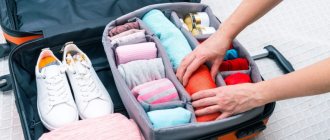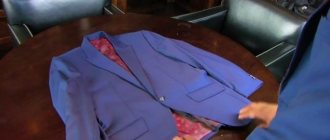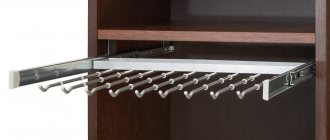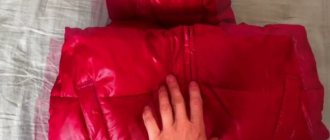Instructions on how to pack a suitcase so as not to damage the appearance of things when unpacking and not to give up your usual accessories on a trip:
- Planning the right amount of clothing. A week's trip is provided using the 5-4-3-2-1 method: no more than 5 sets of underwear, 4 T-shirts, tops or shirts, 3 pairs of trousers (jeans and/or skirts), 2 pairs of shoes, 1 hat.
- Dividing luggage into hand luggage with small accessories that you cannot do without on the road (comb, medicine, napkins, documents, money and other individual small items), and the suitcase itself.
- Ergonomic arrangement of clothes and shoes, which will cause them the least damage when unpacking.
How to compactly pack shoes and socks
There are several ways to pack socks compactly. The first is to put them together, and, starting from the sock to the elastic, roll them into a roll, then use the elastic of one of the socks to make a cuff, thus fastening the pair. Another trick is to place the socks crosswise and begin to overlap one another, tuck the cuffs into the resulting pockets - you get a flat, compact “pad”.
Several pairs of socks are placed inside the shoes. You can put shoe covers or disposable shower caps on your shoes.
Tips on how to pack things in a suitcase will help you take everything you need with you at minimal cost.
You can pack light shoes in boxes. In this case, it becomes possible to place fragile or small objects and souvenirs wrapped in fabric in the empty spaces of the shoe box.
What tools are needed to make figures from towels?
The number of items that will be included in the set of tools for work will depend on the type of figure being created. For some, you won’t need anything other than towels, while for others you will need to stock up on various stationery and decorative supplies. In general, before starting work, prepare:
- stationery erasers;
- decorative ribbons;
- buttons, head pins or beads;
- scissors;
- glue or double-sided tape;
- wrapping paper.
How to fold pants and skirts
How to put things in a suitcase - this is where the preparation for any trip begins, be it a two-day business trip or a long-awaited trip to a resort with the whole family for at least 2 weeks. You should start packing your luggage by packing pants or jeans, as they are the densest and least wrinkled items.
The unfolded pair is folded at the waist by 5-7 cm, then the trouser legs are slightly crossed and smoothed out so that no wrinkles remain. The outer edges are folded towards the center. Next, the pants can be rolled into a tube from the bottom up (to reduce the volume, you can roll it tighter). In the finale, the launch at the waist is turned out so that the bundle is fixed.
The way to fold jeans is to lay them in half lengthwise with the right side facing inward. Then bend the upper trouser leg outwards from you at an angle of 90° by about 25 cm (this will be the width of the finished roll), and begin to roll the roll from the waist to the end of the lower trouser leg. At the end, the bent trouser leg is turned out and put on the folded item, like a cover.
The skirt should always be folded into a rectangle. To do this, you should visually divide it lengthwise into 3 equal parts, then the right and left parts are folded towards the center, with the flared part inward. Depending on the length of the skirt, it can be doubled or tripled, or rolled into a roll.
Instructions for packing items with long sleeves
To fold a knitted jacket or sweater with long sleeves, you need to bend the sleeves towards the middle and lay them at the elbow so that they lie parallel to the side seams. Carefully turn the bottom of the sweater inside out 8-10 cm. Fold the item in half or two-thirds lengthwise and roll it up, starting from the neckline. Turn the folded edge over onto the package - it will secure the twist.
It is also possible to pack a jacket or jacket, although there are special cases for transporting suits, which are guaranteed to allow you to transport it in perfect condition.
But if you need to put your jacket in your luggage, you can use the following trick. Holding it suspended with the buttons facing you, the left shoulder is turned inside out, forming a pocket. The right shoulder is tucked into this improvised cavity. The collar and lapels are straightened.
If the suitcase has a special compartment with fastening straps, then the jacket folded in half should be placed in it. If the jacket does not wrinkle, then after folding it can be placed on a flat surface and rolled into a loose roll. You can place a shirt or rolled-up top inside the resulting fabric tube.
How to put things in a suitcase, especially in a small one, if you need to take a large amount of clothes with you without wrinkling them, there is an unusual technique in which you do not need to fold and fold them separately, especially if these are long dresses and tunics. First of all, the most wrinkled and long items are laid out and straightened out on a flat surface.
They need to be joined one to the other, matching the necks, slightly overlapping layer by layer. The sleeves are spread out to the sides. A bag with linen or other small items is placed in it as a base. Then a so-called “cocoon” is formed from things, starting from the top.
When folding, it is important to follow the lines of the fabric (neck - waist - hem), securing them with sleeves and smoothing out the folds. Thus, a small suitcase can fit up to ten fairly voluminous items for an autumn-winter wardrobe. The straps can be placed around the perimeter of the suitcase.
To pack sports (casual) clothes into a backpack or carry-on luggage, you can use a similar “cocoon” method. First, a sweater or hoodie, or other thickest and warmest item, is laid out on a flat surface. Sweatshirts and T-shirts are laid out on it in an overlapping pattern as their density decreases, matching the sleeves.
Jeans or trousers folded in half are placed on the sleeves. One pair - with the belt towards the center, the other - with the belt down.
In the middle you can put:
- straightened bras;
- 2-3 pairs of tightly folded panties or socks;
- small fragile items.
The cocoon is rolled up as carefully as possible. Things are folded towards the center and the sides are secured with sleeves and trouser legs. It turns out to be an even bundle of 5-6 things, not counting underwear, which can easily fit in any backpack.
How to fold dresses and sundresses
A long sundress is also unrolled on a flat surface before laying. Next, it is smoothed out well so that there are no creases or wrinkles left and is folded down along the waistline. Then the right and left hems are folded towards the center (you can overlap if the skirt is too full) to form a rectangle. Starting from the top (from the waist line), the roll is rolled.
The hem is folded 10-15 cm and a sundress rolled into a tube is placed in the resulting pocket.
Before laying, you can carefully straighten the fabric again. Any dress is a combination of triangles and rectangles, and the same principle should be used when packing them into a suitcase. Even if the hem of a skirt or dress is very wide, these triangles are folded with both parts inside the rectangle.
Folding luggage
When things are prepared, they need to be put in a suitcase so that everything on the list fits and things take up less space.
It is important to pack your luggage not chaotically or as it turns out if the need arises to quickly find and pull out the necessary item. Ultimately, the suitcase should not be too heavy and uncomfortable to transport.
Methods for packing warm clothes
How to put things in a suitcase if you are planning a trip to a different climate zone and need warm, bulky clothes (for example, a down jacket) - you can use a vacuum bag for this, this will save space.
Clothes should be dry and clean, zippers closed, pockets empty. Fur, if present, should be removed. Roll the sleeves inward. The prepared jacket is folded either in half or into a bundle, depending on the length of the down jacket.
The vacuum bag has the following advantages and disadvantages:
- you can place several things in one package;
- the volume of clothing is reduced several times;
- items are protected from external influences and leakage of liquids;
- things that were transported in a bag will have creases and folds when removed, so this method should not be used, for example, for coats and knitwear.
A short (children's) down jacket or padding polyester jacket can also be folded into a roll. To do this, you need to lay it out on a flat surface facing you, fold the sleeves inward overlapping, and bend the bottom of the jacket by 8-10 cm.
Carefully, starting from the neckline, roll up the jacket, then turn the bottom out onto the formed roll, straightening out the folds. A jacket folded in this way can be placed in a regular wide bag and lightly squashed to remove excess air.
How to fold underwear
There are several ways to pack women's and children's panties and men's swimming trunks.
The most popular of them is rolling into a roll, or forming “envelopes”:
- Having laid out the underwear on a flat surface, both parts are folded inward along the width of the gusset, bending the side to form a rectangle. Then the top is folded down one third, and the bottom (gusset) is inserted into the pocket formed by the top.
- The panties are folded in half lengthwise, then folded in half again lengthwise to form a strip. Starting from the bottom, a tight roll is rolled up, which is secured with an elastic band from the panties, turned outward.
- An alternative roll for more compact and aesthetically pleasing packaging of women's lace lingerie requires a certain skill. The laid out laundry is folded into a flagellum, starting from the elastic band. Having reached the gusset, holding the almost rolled roll in your hands, both parts of the rolled roll are folded back overlapping, covering it with the gusset. Then, with movements away from you, the compact tourniquet is turned out until the upper part of the elastic band is at the top.
- Men's boxers are folded lengthwise into thirds - the right side to the left, or vice versa. Then they are folded in half towards the elastic band of the panties, into which the folded underwear is tucked.
- Bras, especially push-up bras, are not recommended to be folded in half. It is better to put them, buttoned up, in one of the bundles formed from bulky clothing. You can put underwear packed in the manner described above inside the cups.
A separate convenient technique for children’s clothing is the formation of sets for a daily change (T-shirt, panties and socks):
- Panties and socks are placed in the center of the unfolded T-shirt, then it is folded into a rectangle and rolled into a tube. The folded bottom edge of the T-shirt is used as a fixation.
- The fixing element can be the cuffs of the socks. To do this, having formed a triple fold of the T-shirt lengthwise, you need to put the socks with the cuffs facing out, retreating 5 cm from the neck of the T-shirt. Then roll the roll up to the bottom of the T-shirt and turn out one sock, putting it on the roll of rolled clothing. Turn the second sock onto the first one to create a compact set that is protected from re-sorting.
Tips for placing cosmetics and toiletries
If, when solving the problem of how to pack clothes in luggage, the main goal is compact placement and safety, then toiletries complicate this task with a standard size of at least 250 ml and the shape of the bottle. Experienced tourists solve this problem by reducing the volume.
For example, regular shampoo and conditioner are poured into special travel kits or other small disposable containers (vitamin jars, conditioner jars, or other disposable packaging). Also, on a short trip, cosmetic samples and two-in-one products are very helpful.
To avoid leakage, the opening of each bottle is wrapped with a sufficient amount of cling film, closed with a lid and placed in ziplock bags. If toiletries are placed in carry-on baggage, you must take into account the airline's requirements for transporting liquids. Most often, their total volume cannot exceed 150 ml.
The same restrictions apply to liquid medicines and baby food. It is better to purchase sunscreen at your destination or in a duty-free area. The price will not differ significantly, and you will not have to bring a bottle of at least 300 ml.
Algorithm for packing things and accessories:
| Underwear/socks | Shoes | Pants and skirts | Tops/T-shirts | Warm clothes/headwear | Cosmetics | |
| Packing method | roll/envelope | roll/envelope | roll/envelope | roll/envelope | organizer | |
| Required quantity (per 1 person) | 5 | 2 | 3 | 4 | 1 | 150ml (hand luggage) |
Things to consider when planning a trip:
- Make a list. This will help you not to forget anything. When arranging your travel bag, visualize the available space. Perhaps some things can be replaced with less voluminous ones.
- Combine sets of things in advance. Choose clothes so that they match the rest of your wardrobe as much as possible.
- Don't take things just in case . Check the weather forecast in advance to ensure you pack the right accessories and wardrobe items.
- You shouldn’t stock up on things for future use that you can easily buy upon arrival. We are talking about soap, hygiene items, and a toothbrush.
- The bottom of the suitcase should be occupied by bulky items and those wardrobe items that you will not need soon. Place toiletries and clothes you plan to change into during your trip on top.
Compact packaging of small items
How to put things in a suitcase if, when packing for the trip, an impressive amount of small items has formed, which are difficult to do without on the road and you don’t want to give up the usual little things you use every day, it’s enough to follow the rules for the correct distribution of items.
They are:
- Use small travel cases designed for travel. Some models are equipped with mesh lids and allow you to see the contents without removing the container from the suitcase. Zip-lock bags are considered the most popular and practical today.
- Divide the travel first aid kit into 2 parts. Medicines needed during the trip are placed in hand luggage and a prescription is attached to them. In order not to cause complaints from border services, it is best to cut the blisters and take no more than 2 tablets of the same type on the road. Other medications (for colds, diarrhea or allergies) should be removed from paper packaging, placed in a recognizable box and packed in a suitcase. Compression socks are a desirable and even necessary item in a traveler's wardrobe. If you fly frequently for many hours and have problems such as varicose veins, they will help avoid swelling.
- Select a special “cosmetic bag” for documents, money, phone and tickets, which should be at hand. The belt “banana” is a panacea for a lot of traveling and transit passengers.
- Minimize the number of items. For example, replace the umbrella with a disposable plastic raincoat.
- A universal adapter will save space and provide an advantage if you need to charge the device from a socket that differs from the Euro standard.
What is it for
Properly storing jeans and other wardrobe items is necessary not only to free up additional space and restore order. There are equally compelling reasons:
- The time spent on ironing is compensated by compactly folded pants.
- An open closet evokes positive emotions in both sexes when beautifully arranged stacks are revealed to the eye.
- The time spent searching for the right pair of jeans is reduced.
A person is able to discover more than one positive aspect for himself by learning how to fold jeans correctly.
Tricks when packing a suitcase
In the compartment of the suitcase, which has retractable handles from the inside, you can put boxes and organizers of suitable size inside and on the side of the bars, using them as a fixing element. With this placement, the object will not move and will retain its shape.
It is advisable to use bags for packing things inside the suitcase. This will protect their contents from unexpected damage and stains.
If you are not planning to pack using the “cocoon” method, then the traditional laying method should start with heavy items at the bottom. You can put your shoes, and in them - chargers, cords and adapters. The most “capricious” objects are placed on top, which must retain their shape.
An important detail is that you need to remove old tags and barcodes. Sorting on the conveyor belt occurs automatically through a scanner, and if the old barcode is read, the luggage can be sent in a different direction.
Packaging film will help protect the suitcase from the outside. For this, thermal film or stretch film is used; ordinary food film is too thin and vulnerable. This technique will protect not only from deformation and leaks, but also from unauthorized opening and theft. To quickly recognize your luggage on the transport belt, it is convenient to use a variety of stickers.
However, it is worth keeping in mind that if airport security staff notice a suspicious item in your luggage, they will remove the film and conduct a manual search - there is a universal key for this.
A few more options for packing your suitcase:
- An economical option is a garbage bag of the appropriate size. The bag is put on the suitcase so that the handle is on top and the wheels are on the bottom. The bag is tightened tightly, then holes for the handle and wheels are cut out and wrapped with tape;
- special belts with fastener;
- protective cover – it will reliably protect the suitcase from the outside and make it unique. But it should be noted that the cases are not cheap.
Proper preparation is the key to a successful trip, especially for a family of several people. Using these tips and algorithms, packing everything you need into your luggage will take a minimum amount of time and effort, making packing and the trip itself comfortable.
Author of the article: IrinaZe
Article design: Oleg Lozinsky
Features of storing pants
Vertical storage is popular today. To prevent jeans and trousers from losing their original appearance, ideally they are stored without folding. A hanger will come to the rescue. It is better to choose a metal one that can withstand loads and takes up little space. Special hangers for jeans with clips on which the pants are attached to the bottom are also suitable. And indeed, things packed compactly do not need ironing and their arrows are better preserved. But for this, at a minimum, you need a good tall wardrobe or a pull-out trouser drawer. You can get by with a horizontal bar on a hanger, but it should be soft and round so that the fabric is not damaged during use.
However, not everyone has the opportunity to store jeans this way. You can put them on shelves, but you need to do this compactly. As you know, folded things lose their appearance faster, so you should follow some simple rules to prevent this from happening:
- All pockets must be empty; any small items must be taken out of them so that they do not print on the front side of the fabric.
- All pocket flaps need to be smoothed out so that they do not stick out, otherwise creases will form on the fabric, which are difficult to get rid of. They stay on jeans forever.
- The waist belt is pulled out so that it does not deform the fabric.
- If the jeans are not hemmed, but rolled up, then store them turned away.
- Fold the legs compactly so that the side seams match and do not form creases during storage.
- There is no need to turn the instep seam, otherwise unsightly prints will form in this place.
In this form, folded jeans will be stored for a long time and will not lose their original appearance. Needless to say, before putting the trousers on the shelf, they must be washed, ironed and dried well. Only store completely dry items so that there is no musty smell in the closet.
Advice! Special sachets are used for flavoring.











